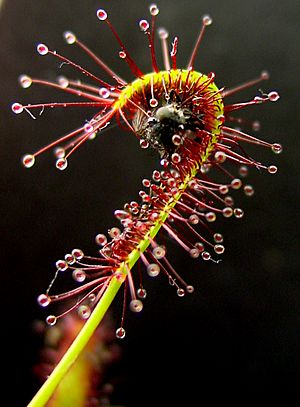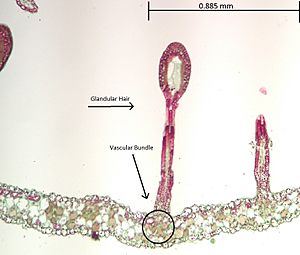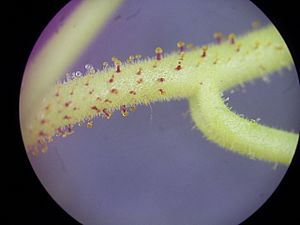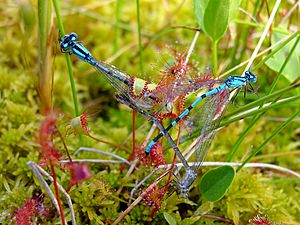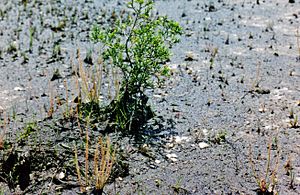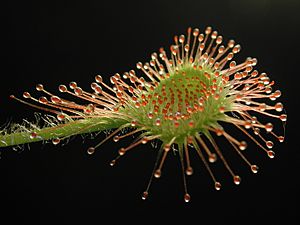Sundews facts for kids
Quick facts for kids Sundews |
|
|---|---|
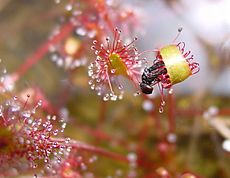 |
|
| Drosera anglica | |
| Scientific classification | |
| Kingdom: | |
| (unranked): | |
| (unranked): | |
| (unranked): |
Core eudicots
|
| Order: | |
| Family: | |
| Genus: |
Drosera
|
Drosera, also known as Sundews, are amazing carnivorous plants. They catch and eat insects using a thick, sticky goo called mucilage. This goo is on special hairs called tentacles. Sundews are very common carnivorous plants. There are at least 188 different kinds, or species, of sundews. You can find them almost everywhere in the world, except for Antarctica. Many sundew species live for two or more years. Some even live for up to 50 years! Other types only live for one year and grow new plants from seeds.
Contents
What are Sundews?
The scientific name Drosera comes from an old Greek word meaning "dew, dewdrops." Its English name, sundew, comes from Latin and means "dew of the sun." Both names describe the sweet, sticky goo that covers the plant's tentacles. This goo attracts insects, like flies, day and night. The mucilage also has special chemicals called enzymes. These enzymes help the plant break down and digest the insects. This way, the sundew gets important nutrients like nitrogen from the insects. Like all plants, sundews make their own food using sunlight. They just use insects for extra nitrogen and other nutrients they can't get from the soil.
Most sundews are small, about 5 inches (12.7 cm) tall. This is about the size of an adult's hand. But some climbing sundews can grow much taller. One type, Drosera erythrogyne, can grow up to 30 feet (9 meters) long! Sundew roots are usually not very strong. They mostly help the plant take in water and stay in the ground.
Different Kinds of Sundews
Sundews grow in different ways depending on where they live. Here are some main types:
- Temperate Sundews: These sundews grow in places with cold winters. They form a tight ball of leaves called a hibernaculum to sleep through the winter. All sundews in North America and Europe are this type.
- Subtropical Sundews: These sundews live in warm places where the weather stays the same all year. They keep growing without stopping.
- Pygmy Sundews: About 40 different small sundew species live in Australia. They are tiny and grow special buds called gemmae to make new plants. They also have thick hairs to protect them from the strong Australian sun.
- Tuberous Sundews: Nearly 50 Australian sundew species grow underground tubers. These tubers help them survive very dry summers. They pop up again when the weather gets cooler and wetter. Some tuberous sundews grow in rosettes (like a rose flower), and others have climbing stems.
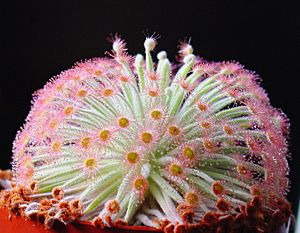
- Petiolaris Complex: These 14 tropical Australian sundew species live in warm places that can be very wet or sometimes dry. Many of them have hairy leaf stalks (petioles). These hairs help keep the plant moist and collect morning dew.
- Queensland Sundews: This small group of three species (D. adelae, D. schizandra, and D. prolifera) lives in very wet, shady rainforests in Australia.
How Sundews Catch Food
Sundews have special sticky tentacles on their leaves. These tentacles are covered with sweet, sticky goo. This goo attracts insects. When an insect touches the goo, it gets stuck. The goo then traps the insect, making it unable to move or breathe. The insect usually dies within 15 minutes.
While the insect is trapped, the sundew releases special enzymes. These enzymes break down the insect's body. This turns the insect into a nutrient-rich liquid. The plant then absorbs these nutrients through its leaves.
Sundews can move their tentacles! When an insect touches a tentacle, it slowly bends towards the center of the leaf. This helps the plant get more of its sticky glands onto the insect. Even a tiny gnat touching one tentacle can make it move. This movement is called thigmonasty. Some sundews, like D. burmannii and D. sessilifolia, can bend their outer tentacles in seconds. D. glanduligera can do it in tenths of a second!
Some sundews can even bend their whole leaves to hug their prey. D. capensis is famous for this. It can curl its leaf completely around an insect in about 30 minutes. However, some species, like D. filiformis, cannot bend their leaves at all.
Some Australian sundews, like D. indica, have strange red and yellow growths. Scientists are still studying what these growths do. They might help attract more insects.
Sundew leaves come in many different shapes. They can be round, like in D. erythrorhiza, or long and branched, like in D. binata.
Flowers and Fruit
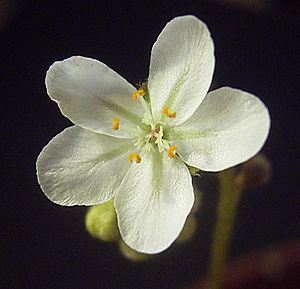
Sundew flowers grow on long stems, far above the sticky leaves. This helps make sure that insects that pollinate the flowers don't get trapped by the sticky leaves. The flowers usually open one at a time and only for a short time. They often open when there is direct sunlight. The flower stalks also follow the sun's movement in the sky.
Most sundew flowers have five petals and are small, less than 0.6 inches (1.5 cm) across. But some, like D. regia, have much larger flowers, over 1.6 inches (4 cm) wide. Sundew flowers are usually white or pink. Australian species have many colors, including orange, red, yellow, or even metallic violet.
After the flower is pollinated, it forms a seed pod. This pod contains many tiny seeds.
Roots
Most sundews have weak root systems. Their roots mainly help them soak up water and stay in the ground. They don't get many nutrients from the soil. Some South African sundews use their roots to store water and food. Some Australian species form underground corms (like bulbs) that help them survive dry summers. These corms can also grow new plants.
Pygmy sundews often have very long roots compared to their small size. A tiny 0.4-inch (1 cm) plant can have roots that go over 6 inches (15 cm) deep!
Reproduction and Life Cycle
Many sundew species can pollinate themselves. Their flowers often self-pollinate when they close. This usually produces many tiny black seeds. Seeds from sundews that live in warm places sprout when they get moisture and light. Seeds from sundews in colder places need a cold, wet period before they can sprout. Tuberous sundew seeds need a hot, dry summer followed by a cool, wet winter to sprout.
Sundews can also make new plants without seeds. This is called vegetative reproduction. Some species grow new plants from their roots or from older leaves that touch the ground. Pygmy sundews use special scale-like leaves called gemmae to make new plants. Tuberous sundews can grow new plants from their corms.
People who grow sundews can also make new plants from leaf, crown, or root cuttings.
Where Sundews Live
Sundews grow all over the world, from Alaska in the north to New Zealand in the south. Australia has the most different types of sundews, with about half of all known species. South America and southern Africa each have more than 20 species. A few species are also found in parts of Europe, Asia, and North America.
Europe has only three species: D. intermedia, D. anglica, and D. rotundifolia. North America has these three plus four more species.
Sundews are often called "cosmopolitan," meaning they are found worldwide. However, they are not found in very dry places, most rainforests, or the American Pacific Coast. They are also rare in the Mediterranean region and North Africa.
Where Sundews Grow
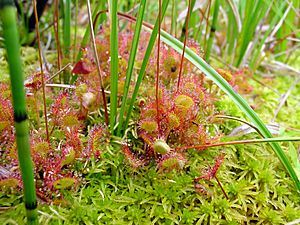
Sundews usually grow in places that are wet for part of the year, or sometimes always wet. They like acidic soils and lots of sunlight. Common places where they grow include bogs, fens, swamps, and wet streambanks. Many sundews grow with sphagnum moss. This moss soaks up many nutrients from the soil and makes the soil acidic. This means other plants can't grow as well, allowing sundews to thrive.
Even though they like wet, sunny places, sundews can adapt to different environments. Some live in rainforests, deserts (like D. burmannii), and even shady places (like Queensland sundews). Sundews that live in cold places form special buds to survive winter. Generally, sundews prefer warm climates and don't like too much frost.
Protecting Sundews
Many sundew species are protected by law in countries like Germany, Austria, and France. The biggest threat to sundews in Europe and North America is losing their habitats. This happens when land is used for buildings, farms, or when bogs are drained for peat. This has caused some sundew species to disappear from places where they used to grow. It's hard to bring them back once their habitat is gone.
In South Africa and Australia, where many sundews live, human activities also threaten their homes. Growing cities and draining wet areas for farming and logging are big problems. Long droughts in Australia also dry up places where sundews live.
Collecting plants from the wild is a big threat to species that only grow in small areas. For example, D. madagascariensis is endangered in Madagascar. This is because millions of these plants are collected each year to be sold for medicine.
How People Use Sundews
Sundews as Medicine
People have used sundews as medicine for a long time, since the 12th century. An Italian doctor once described it as a remedy for coughs. Sundew tea was often used for dry coughs, bronchitis, whooping cough, and asthma. Modern studies show that sundew can help with coughs.
In the past, sundews were also used to strengthen the heart, treat sunburn, and toothaches. Today, sundews are still used in many medicines, often mixed with other herbs. They are used to treat problems like asthma, coughs, lung infections, and stomach ulcers.
The roots, flowers, and seed pods are mainly used for medicine. Since many sundews are protected, the plants used for medicine are often grown on farms. Some are also collected from places like Madagascar and Spain.
Sundews as Houseplants
Because they are carnivorous and have beautiful, sparkling traps, sundews are popular ornamental plants. However, most species need special care, so they can be hard to grow at home. But some tougher types are sold in stores, often next to Venus flytraps. These include D. capensis, D. aliciae, and D. spatulata.
To grow sundews, they usually need very moist soil. The water must be pure, like distilled or rain water. This is because nutrients or salts in regular water can harm them. People often grow them in a mix of sphagnum moss, peat moss, sand, or perlite.
Other Uses for Sundews
The underground corms of Australian tuberous sundews are eaten by Aboriginal Australians. Some of these corms were also used to dye fabrics. A purple or yellow dye was also made from D. rotundifolia in Scotland. There is even a sundew liqueur (a type of drink) made from a 14th-century recipe. It uses fresh leaves from species like D. capensis and D. rotundifolia.
Images for kids
-
A tuber of D. zonaria starting to grow in winter
-
A crane fly trapped by Drosera filiformis
See also
 In Spanish: Drosera para niños
In Spanish: Drosera para niños


